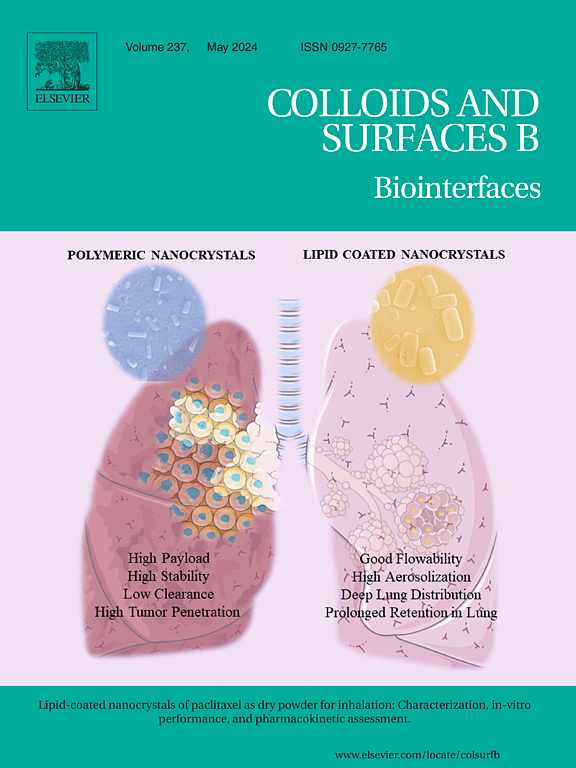nir触发的温度敏感聚多巴胺纳米系统,具有快速的按需释放相变,以增强抗菌和抗生物膜性能
IF 5.6
2区 医学
Q1 BIOPHYSICS
引用次数: 0
摘要
抗生素滥用和细菌生物膜屏障对全球公共卫生构成巨大挑战。为了解决这一问题,我们通过将银纳米颗粒(AgNPs)和姜黄素(Cur)与相变材料1-十四醇结合,开发了一种近红外(NIR)触发的温度敏感聚多巴胺纳米系统(PDA@Ag@Cur@PCM)。该系统实现了nir触发的按需药物释放和协同光热化学抗菌,显著提高了抗菌和抗生物膜效果。在近红外下,PACP优异的光热转换能力诱导了1-十四醇的相变,促进了Cur和Ag⁺的精确释放。PACP纳米系统不仅能有效抑制细菌群体感应(QS),还能保证Ag⁺介导的抗菌活性。此外,轻度光热疗法(PTT)在保持良好的组织生物相容性的同时获得了有效的抗菌效果,从而最大限度地减少了全身毒性。体外研究表明,纳米平台有效地破坏成熟的生物膜,显著降低ATP水平和总碳水化合物含量,同时对金黄色葡萄球菌(98.3% %)和大肠杆菌(97.2% %)具有显著的抗菌效果。通过将低温光疗与可控的Cur +和Ag +释放相结合,PACP纳米系统代表了一种安全高效的无抗生素替代方案,为后抗生素时代对抗感染提供了一种有希望的解决方案。本文章由计算机程序翻译,如有差异,请以英文原文为准。
NIR-triggered temperature-sensitive polydopamine nanosystem with rapid phase transition for on-demand release to enhance antibacterial and antibiofilm performance
The antibiotic abuse and bacterial biofilm barriers pose a formidable challenge to global public health. To address this issue, we developed a near-infrared (NIR)-triggered temperature-sensitive polydopamine nanosystem (PDA@Ag@Cur@PCM) by integrating silver nanoparticles (AgNPs) and curcumin (Cur) with the phase change material 1-tetradecanol. The system achieved NIR-triggered on-demand drug release and synergistic photothermal-chemo antibacterial, significantly enhancing antibacterial and antibiofilm efficacy. Under NIR, the outstanding photothermal conversion capability of PACP induces the phase transition of 1-tetradecanol, facilitating precise release of Cur and Ag⁺. The PACP nanosystem can not only effectively suppress bacterial quorum sensing (QS) but also ensure Ag⁺ mediated antibacterial activity. Moreover, mild photothermal therapy (PTT) achieved potent antibacterial effects while maintaining excellent tissue biocompatibility, thereby minimized systemic toxicity. In vitro studies demonstrated that the nanoplatform efficiently disrupts mature biofilms, significantly reduces ATP levels and total carbohydrate content, while achieving remarkable antibacterial effects against S. aureus (98.3 %) and E. coli (97.2 %). By integrating low-temperature phototherapy with controlled Cur and Ag⁺ release, the PACP nanosystem represents a safe and highly effective antibiotic-free alternative, offering a promising solution for combating infections in the post-antibiotic era.
求助全文
通过发布文献求助,成功后即可免费获取论文全文。
去求助
来源期刊

Colloids and Surfaces B: Biointerfaces
生物-材料科学:生物材料
CiteScore
11.10
自引率
3.40%
发文量
730
审稿时长
42 days
期刊介绍:
Colloids and Surfaces B: Biointerfaces is an international journal devoted to fundamental and applied research on colloid and interfacial phenomena in relation to systems of biological origin, having particular relevance to the medical, pharmaceutical, biotechnological, food and cosmetic fields.
Submissions that: (1) deal solely with biological phenomena and do not describe the physico-chemical or colloid-chemical background and/or mechanism of the phenomena, and (2) deal solely with colloid/interfacial phenomena and do not have appropriate biological content or relevance, are outside the scope of the journal and will not be considered for publication.
The journal publishes regular research papers, reviews, short communications and invited perspective articles, called BioInterface Perspectives. The BioInterface Perspective provide researchers the opportunity to review their own work, as well as provide insight into the work of others that inspired and influenced the author. Regular articles should have a maximum total length of 6,000 words. In addition, a (combined) maximum of 8 normal-sized figures and/or tables is allowed (so for instance 3 tables and 5 figures). For multiple-panel figures each set of two panels equates to one figure. Short communications should not exceed half of the above. It is required to give on the article cover page a short statistical summary of the article listing the total number of words and tables/figures.
 求助内容:
求助内容: 应助结果提醒方式:
应助结果提醒方式:


